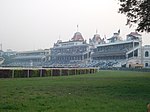Kolkata metropolitan area
Kolkata Metropolitan Area (abbreviated KMA; formerly Calcutta Metropolitan Area), also known as Greater Kolkata, is the urban agglomeration of the city of Kolkata in the Indian state of West Bengal. It is the third most populous metropolitan area in India after Delhi and Mumbai. The area is administered by the Kolkata Metropolitan Development Authority (KMDA). The area covers four municipal corporations along with 37 municipalities. Kolkata metropolitan district was legally defined in the schedule of the Calcutta Metropolitan Planning Area (Use and Development of Land) Control Act, 1965 (West Bengal Act XIV of 1965), and, after repeal of that Act, redefined as Kolkata metropolitan area in the first schedule of West Bengal Town and Country (Planning and Development) Act, 1979 (West Bengal Act XIII of 1979).
Excerpt from the Wikipedia article Kolkata metropolitan area (License: CC BY-SA 3.0, Authors).Kolkata metropolitan area
Kidderpore Road, Kolkata Hastings (Kolkata District)
Geographical coordinates (GPS) Address Nearby Places Show on map
Geographical coordinates (GPS)
| Latitude | Longitude |
|---|---|
| N 22.5411 ° | E 88.3378 ° |
Address
Kolkata Race Course
Kidderpore Road
700022 Kolkata, Hastings (Kolkata District)
West Bengal, India
Open on Google Maps









